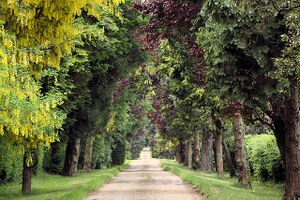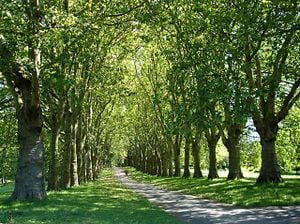
 A mecca for rewilders: the community-led project restoring Scotland’s southern uplands, theguardian.com (Mar 20, 2024)
A mecca for rewilders: the community-led project restoring Scotland’s southern uplands, theguardian.com (Mar 20, 2024)  ‘We’ve had untold support’: how farmers are getting creative with tree-planting, positive.news (Dec 12, 2023)
‘We’ve had untold support’: how farmers are getting creative with tree-planting, positive.news (Dec 12, 2023)  ‘Darwin’s oak’ to be felled to make way for Shrewsbury bypass, theguardian.com (Nov 01, 2023)
‘Darwin’s oak’ to be felled to make way for Shrewsbury bypass, theguardian.com (Nov 01, 2023)

Community action projects[edit | edit source]
- community tree planting
- local rewilding opportunities
- help map the lost rainforests of Britain, see Maps
- Add a tree to the Ancient Tree Inventory, ati.woodlandtrust.org.uk, added 11:55, 5 October 2023 (UTC)
Events[edit | edit source]
 Nov 25 - Dec 3, 2023 (Sat - Sun) — National Tree Week
Nov 25 - Dec 3, 2023 (Sat - Sun) — National Tree Week
Networks[edit | edit source]
- Future Forests Network, not for profit Community Interest Company focused on improving the connection between volunteer tree planters, community event organisers and land owners.
Resources[edit | edit source]
Organisations working with communities[edit | edit source]
The Woodland Trust is the largest woodland conservation charity in the UK. It has over 500,000 supporters.
The Trust has three key aims:
- protect ancient woodland which is rare, unique and irreplaceable
- restoration of damaged ancient woodland, bringing precious pieces of our natural history back to life
- plant native trees and woods with the aim of creating resilient landscapes for people and wildlife.
Established in 1972, the Woodland Trust now has over 1,000 sites in its care covering over 29,000 hectares. Access to its woods is free.[1]
Woodland Trust W
Maps[edit | edit source]
- Where could we create woodland in England? Trees map from Friends of the Earth, friendsoftheearth.uk, added 16:10, 30 March 2023 (UTC)
- Interactive map of the Lost Rainforests of Britain, map.lostrainforestsofbritain.org, added 16:24, 31 October 2022 (UTC)
- Take action: help map the lost rainforests of Britain lostrainforestsofbritain.org, project started early 2021 by Guy Shrubsole, author of Who Owns England?, to explore, photograph, map, and (with luck) help to restore the lost rainforests of Britain. At first focused on England, and particularly the Westcountry, where Guy lives. It's now been extended to cover the whole of Britain. added 15:14, 4 January 2022 (UTC)
- Public events map from futureforestsnetwork.org, maps long term planting projects, one day events, rewilding projects and tree nurseries, added 15:58, 1 December 2021 (UTC)
- Woodland opportunity mapping, Where could we create woodland in England? takeclimateaction.uk, added 17:13, 1 October 2020 (UTC)
Other resources[edit | edit source]
- Apply for a community tree pack (added Nov 2016) woodlandtrust.org.uk
- Manifesto for Tress from Common Ground
- Grow Trees, The Conservation Volunteers
- Trees in the Townscape, a Guide for Decision Makers, from Trees and Design Action Group
Community forests in England[edit | edit source]
England's twelve community forests are afforestation-based regeneration projects which were established in the early 1990s. Each of them is a partnership between the Forestry Commission and the Countryside Agency, which are agencies of the British government, and the relevant local councils.
Most of the designated areas are close to large cities and contain large amounts of brownfield, underused and derelict land. When the forests were created the average forest cover in the designated areas was 6.9%, and the target is to increase this to 30% over about 30 years. As most of the land is in private ownership the schemes rely mainly on providing landowners with incentives to plant trees. However the forests contain areas of publicly accessible open land, and increasing public access is one of the objectives. W
Ancient woodland[edit | edit source]
In the United Kingdom, ancient woodland is that which has existed continuously since 1600 in England, Wales and Northern Ireland (or 1750 in Scotland). Planting of woodland was uncommon before those dates, so a wood present in 1600 is likely to have developed naturally.
In most ancient woods, the trees and shrubs have been cut down periodically as part of the management cycle. Provided that the area has remained as woodland, the stand is still considered ancient. Since it may have been cut over many times in the past, ancient woodland does not necessarily contain very old trees.
For many species of animal and plant, ancient woodland sites provide the sole habitat, and for many others, conditions on these sites are much more suitable than those on other sites. Ancient woodland in the UK, like rainforest in the tropics, is home to rare and threatened species. For these reasons ancient woodland is often described as an irreplaceable resource, or 'critical natural capital'. The analogous term used in the United States, Canada and Australia (for woodlands that do contain very old trees) is "old-growth forest".
Ancient woodland is formally defined on maps by Natural England and equivalent bodies. Mapping of ancient woodland has been undertaken in different ways and at different times, and the quality and availability of data varies from region to region, although there are some efforts to standardise and update it.
- Ancient woodland, information from The Woodland Trust
Temperate rainforests[edit | edit source]
The woodlands are variously referred to in Britain as Upland Oakwoods, Atlantic Oakwoods, Western Oakwoods or Temperate Rainforest, Caledonian forest, and colloquially as 'Celtic Rainforests'. They are also listed in the British National Vegetation Classification as British NVC community W11 and British NVC community W17 depending on the ground flora. The majority of surviving fragments of Atlantic Oakwoods in Britain occur on steep-sided slopes above rivers and lakes which have avoided clearance and intensive grazing pressure. There are notable examples on the islands and shores of Loch Maree, Loch Sunart, Loch Lomond and one of the best preserved sites on the remote Taynish Peninsula in Argyll. There are also small areas on steep-sided riverine gorges in Snowdonia and Mid Wales. In England, they occur in the Lake District (Borrowdale Woods) and steep-sided riverine and estuarine valleys in Devon and Cornwall and the Microclimate disused slate & granite quarries in these counties. This includes the Fowey valley in Cornwall and the valley of the river Dart which flows off Dartmoor and has rainfall in excess of 2 metres per year. W
- What is a Temperate rainforest? lostrainforestsofbritain.org
Campaigns[edit | edit source]
- Kent quarry extension is one of the biggest threats of the 21st century. Hermitage Quarry expansion plans: If approved, the loss could even surpass ancient woodland losses from the Lower Thames Crossing and HS2 schemes combined, woodlandtrust.org.uk, added 14:04, 9 August 2023 (UTC)
- Save The Oaks, a radical act of love, Extinction Rebellion Rewilding see also: Biodiversity UK, Resources, added 17:15, 8 January 2021 (UTC)
- The Charter for Trees, Woods and People
- Save Our Woods
Personal options[edit | edit source]
See also[edit | edit source]
- Trees, woodland and forest
- Biodiversity UK
- Climate action UK
- Environment quality UK
- Open spaces UK
- Rural sustainability UK
- Urban sustainability UK
local information can be found, or shared, via our many UK location pages
External links
- Wikipedia: Hedge, Hedge laying
- Plant a Hedge, soilassociation.org, added 16:52, 9 March 2022 (UTC)
- Hedgelink, link checked 16:53, 9 March 2022 (UTC)
- The Tree Council, link checked 16:58, 9 March 2022 (UTC) W
- Trees and Design Action Group
References
- ↑ Press release, Oct 22, 2021, woodlandtrust.org.uk/press-centre, Landscape-scale conservation, woodlandtrust.org.uk

